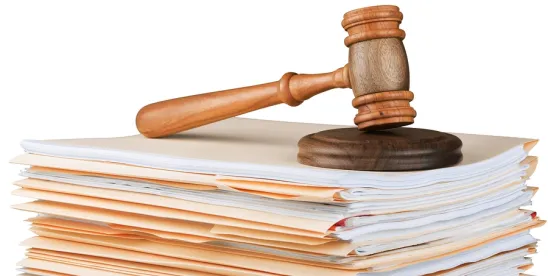A recent Delaware Court of Chancery decision provides useful guidance regarding the requirements to preserve evidence in litigation and the potential penalties for spoliation. In the matter styled: In re Facebook, Inc. Derivative Litigation, C.A. Cons. No. 2018-0307-JTL (Del. Ch. Jan. 21, 2025), the court addressed spoliation in litigation involving allegations that Facebook sold personal information in violation of applicable obligations it had to its social media users.
I. Factual Background
Although several million documents were produced in the litigation, this decision involved a motion alleging that the COO of Facebook and one of the members of the board of directors failed to preserve their personal email accounts which were used at least occasionally for business communications relevant to the lawsuit.
II. Legal Analysis
The legal definition for spoliation is the destruction or significant alteration of evidence, or the failure to preserve evidence properly, or the improper concealment of evidence. Slip op. at 11 (citing Goldstein v. Denner, 310 A.3d 548, 567 (Del. Ch. 2024)).
Court of Chancery Rule 37(b) authorizes spoliation sanctions for failure to preserve ESI and requires that before sanctions can be imposed, it must be shown that: (1) The responding party had a duty to preserve the ESI; (2) The ESI is lost; (3) The loss is attributable to the responding party’s failure to take reasonable steps to preserve the ESI; and (4) The requesting party suffered prejudice. Moreover, in order for an adverse inference or case dispositive sanctions, the plaintiff must show that the responding party recklessly or intentionally failed to preserve ESI. Slip op. at 12.
III. When Court Should Decide Spoliation Motion
The court recited factors it will consider to determine whether to address a spoliation motion before trial or after trial. Slip op. at 13-14.
IV. When a Duty to Preserve Exists
- The first question under Rule 37(e) is whether ESI should have been preserved.
The court emphasized that: “A party is not obligated to preserve every shred of a paper, every e-mail or electronic document.” Slip op. at 14-15 and footnote 51. But the party must preserve what it reasonably should know is relevant to the action. The duty applies to key people likely to have relevant data.
- The second step in a Rule 37(e) analysis is whether the ESI is lost. For purposes of Rule 37(e), information is lost only if it is irretrievable from another source including other custodians. Slip op. at 17.
- The third step in the Rule 37(e) analysis is whether ESI was lost because of the failure of a party to take reasonable steps to preserve it.
In order to understand preservation, we must understand the components of ESI discovery.
The court reviewed the five steps involved in ESI discovery: (i) Identification; (ii) Preservation; (iii) Collection; (iv) Review; and (v) Production. In this case the issues were identification and preservation.
(i) Identification: Taking reasonable steps to identify ESI is the first step in preserving evidence or information which should be collected and preserved. This involves locating the relevant people that have custody of the relevant ESI or the ability to obtain it, as well as the location of types of ESI. Slip op. at 18. This may involve interviewing individuals that might have information about the location of relevant ESI.
(ii) Whether there was a failure to take reasonable steps to preserve: The next step is to preserve ESI, but a party “need not preserve all documents in its possession; it must preserve what it knows and reasonably ought to know is relevant to possible litigation and is in its possession, custody, or control.” Slip op. at 19.
Importantly, the court explained that it should be “sensitive to the parties’ sophistication with regard to litigation in evaluating preservation efforts; some litigants, particularly individual litigants, may be less familiar with preservation obligations than others who have considerable experience in litigation.” Slip op. at 19.
(iii) Steps Necessary to Preserve
The court distinguished between the practical steps an organization must take to preserve compared to an individual, but both must suspend routine document destruction policies. Slip op. at 20. For example, individuals must disable auto-delete functions, and also backup data for personal devices. Failure to do so may suggest they acted unreasonably. An individual must self-educate in order to learn what is necessary to prevent automatic deletion or destruction.
Applying the standards to the Facebook case, the court found that the COO was highly sophisticated as the chief operating officer and she knew what was required. She should have consulted company counsel if she had any doubts. Her failure to take steps to avoid the auto-deletion of her email was not reasonable. Slip op. at 21-22.
The court also explained that the director of the company who failed to disable his auto-delete function for his personal emails acted unreasonably, but in his case there was no prejudice.
V. Prejudice Required
If there was no prejudice from the loss of ESI, no sanctions are imposed. Slip op. at 23. The court explained what prejudice means in this context.
The prejudice analysis requires that the requesting party provide an explanation as to why the lost ESI could have been relevant, but “the mere fact that evidence is lost is not sufficient to demonstrate prejudice; the requested party must provide a plausible explanation as to why evidence could have been relevant such that the failure to preserve is prejudicial.” Slip op. at 24.
Once the party seeking sanctions meets the initial burden, the party who failed to preserve must convince the court that the lost ESI did not result in prejudice, such as: because the material could not have been relevant, or would not have been admissible, or could not have been used by the requesting party to its advantage. Slip op. at 24.
The court explained why the loss of the COO’s emails was prejudicial—but why there was no prejudice from the emails of the board member that were lost. Slip op. at 25-27.
VI. Sanctions
The court rejected most of the requests for sanctions, and only imposed an elevated requirement for the burden of proof, as well as an award of fees for bringing the motion for sanctions. Slip op. at 29.




 />i
/>i

